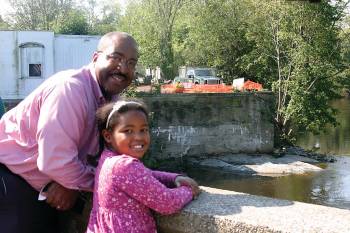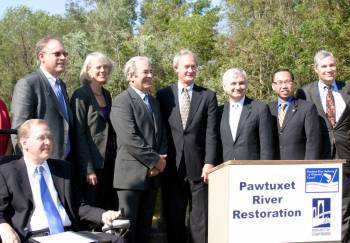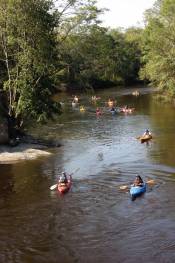Village celebrates dam removal, opening Pawtuxet to migratory fish
Warwick Beacon Online
October 10, 2011 By Jessica
 |
>  |
 |
|
| Steven Craddock, of Cranston, often takes his daughter, Georgia, 9, to sight-see at the Pawtuxet River. Now that the dam has been removed, they look forward to future outdoor activities they can do together. |
Pictured are (from left) Congressman Jim Langevin, Curt Spalding, Janet Coit, Bob Nero, Governor Lincoln Chafee, Senator Jack Reed, Cranston Mayor Allan Fung and Senator Sheldon Whitehouse. |
Paddling the Pawtuxet: At an event on Friday morning, kayakers floated up the Pawtuxet. |
Georgia Craddock, 9, of Cranston, has visited Pawtuxet “many times” in her life to stand on the bridge and look at the Pawtuxet River. But, Friday’s bright and sunny morning was the first occasion when she witnessed a group of kayakers paddle downstream, through the falls, under the bridge, and into Pawtuxet Cove.
“Seeing the kayakers going up the stream was really awesome,” she said.
Her father, Steven, agreed. He is looking forward to future outdoor activities he can do with Georgia now that the dam has been removed, which ultimately restores populations of native migratory fish that have been blocked from accessing their natural spawning habitat for more than 300 years.
“It’s great,” Steven said. “It’s bringing back the environment and helping the community. Now, we can do nature walks and actually get in a kayak and go out on the river.”
Through a partnership between the Pawtuxet River Authority & Watershed Council, the Narragansett Bay Estuary Program, plus nearly 20 other organizations, the project to improve the ecosystems of the Pawtuxet River watershed and Narragansett Bay gained momentum with the removal of the Pawtuxet Falls Dam.
River herring and American shad are food sources for bluefish, striped bass, largemouth bass, herons, ospreys and other fish. Biologists estimate that more than 100,000 herring and shad will return to spawn in the Pawtuxet. It also will help to reduce flooding impacts upstream, allow water to flow faster and cooler, and improve water quality.
According to a press release, the dam was built in 1924. In August, contractors used excavators fitted with hydraulic hammers to disassemble the 150-foot concrete dam spillway. It re-established seven miles of free flowing river habitat to the Pawtuxet, increasing velocity and reducing river depth by two to three feet.
Robert Nero, Chair of the Pawtuxet River Authority & Watershed Council, attended the event and spoke about the project, which took nine years to complete.
“There is no rule that maintains an urban river must be a polluted river,” he said. “Part of what this accomplished was to restore these falls to their original state. We removed a barrier, which will now allow long absent species of fish back into the largest amount of surface fresh water habitat of any watershed in the state. These fish live their lives in the ocean but they give birth only in fresh water. It restores an underutilized, valuable connectivity between Narragansett Bay and the Pawtuxet River.”
He said that in 1972, in the midst of an overwhelming national movement to protect life supporting natural resources, Congress legislated the reorganization of the Federal Water Pollution Control amendments of 1948, which is now known as the Federal Clean Water Act.
“This project would not be possible today if not for the Clean Water Act,” said Nero. “In this effort, the United States created a profound standard of environmental behavior for industries programmed to protect that which what we have, a means to prepare what we’ve damaged and a major opportunity for citizens to play a role. We’ve removed hundreds of tons of debris and created a historic recreational access to the river and have been instrumental in creating the Pawtuxet River Authority Bond Fund. Let me assure you that today the Pawtuxet is a valuable resource in the state of Rhode Island.”
The Pawtuxet River Authority conceived the project in 2002. It wasn’t long before project supporters realized many other agencies shared their vision. Removal of the dam and riverbank plantings to take place this fall were largely made possible with a $600,000 grant from USDA Natural Resources Conservation Service and the Rhode Island Department of Environmental Management.
In addition, several elected officials were in favor of the project. Eight attended Friday’s event, including Governor Lincoln Chafee.
“The large crowd is evidence of how many people and agencies that have worked hard over the decades to bring this to fruition,” said Chafee. “We worked over the years to get this water clean. Taking down this dam is another step to providing seven and a half miles of access up the river.”
Senator Sheldon Whitehouse was also in attendance. He agreed with Chafee.
“Who knew that this could get this kind of attention from so many officials?” said Whitehouse. “Everybody knows about Rhode Island’s coast and beaches; everybody knows about Rhode Island’s sailing heritage, but our rivers are really an unsung resource. For me, it’s really exciting to see this turnout and this recognition as we work to make our rivers assessable and clean for tourism and recreation.”
Senator Jack Reed also agreed and said the removal of the dam has many positive impacts, both environmental and economic.
“Over the last few years, we have been looking at flooding from potential hurricanes and removing this dam helps us to deal with these crises,” he said. “It’s not just about getting a project done but demonstrating that when we work together…we can accomplish terrific things.”
Cranston Mayor Allan Fung applauded the partnership and hopes it continues so more communities reap the benefits of dam removals in the future.
“We’ll have a lot more opportunities,” Fung said. “It will have an impact for Cranston, Warwick, and Rhode Island. ”
While Mayor Scott Avedisian was unable to attend, as he was out of the country, City Council President Bruce Place was at the celebration. He said that since he and Avedisian were raised in Pawtuxet, the project has a special meaning.
“I grew up about a mile upstream and I currently live about a mile and a half upstream,” Place said. “The Pawtuxet River has always been a part of my life. This is a great day for the City of Warwick and the City of Cranston. This vitality important restoration initiate will return [the river] to its former splendor not seen since the 1700s. It can be a showcase for future programs that require federal, state, local, volunteer organizational support to succeed. Let us continue to consider new projects and develop new programs as a model for success.”
Congressman James Langevin also grew up near the village. He said he has fond memories of the river and is pleased to have the opportunity to make many more.
“It’s a thrilling experience to see that dam removed,” he said. “I remember fishing off the side of the bridge and having good times with friends and my brother, so it has a special place in my heart. The removal of the dam is going to have measurable impacts on the environment…It’s also going to protect homeowners, as it will prevent future flooding.”
However, he mentioned an effort in Washington that aims to “roll back” many of the protections that have been put forth over the years, particularly, the Clean Water and Clean Air Acts.
“If you think back to the days where people could dump whatever pollutants or toxins into our waterways, there was so much damage,” Langevin said. “We cannot allow those protections to be rolled back. We have to be vigilant to protect our children and our environment.”
State Senator Joshua Miller and State Representative Joseph M. McNamara addressed the assembly, echoing much of what Chafee, Whitehouse, Reed, Fung, Place, and Langevin said.
Also, representatives from partnering agencies were in attendance and spoke about the project. They included Jonathan Stone, Executive Director of Save the Bay; Janet Coit, Director of Rhode Island Department of Environmental Management; Anne Maxwell Livingston, Chair Rhode Island Coastal Resources Management Council; Phoukham “Pooh” Vongkjamdy, State Conservationist for USDA/NRCS; Paul Phifer, Assistant Regional Director U.S. Fish & Wildlife Service; John Catena, Northeast Supervisor of N.O.A.A. Restoration Center; Curt Spalding, Regional Administrator of the U.S. E.P.A. Environment; and Thomas Ardito, Project Manager of the Narragansett Bay Estuary Program.
Rita L. Holahan, Treasurer of the Pawtuxet River Authority, as well as Richard Ribb, Director of the Narragansett Bay Estuary Program, served as the masters of ceremony. Ribb said Ardito has “lived and breathed this project for the last nine or ten years.”
Ardito said while the purpose of the project was to bring back the migration of fish important for fish and wildlife, as well as commercial and recreational fisheries in Rhode Island, it does more than that.
“In removing a dam like this, we’re really restoring a whole range of natural characteristics of that river,” he said. “A project this scale won’t solve catastrophic floods, but it will certainly help. As we celebrate the completion of this project, let’s look at it as the beginning of much more work we would like to do with the Pawtuxet River Watershed and throughout the Narragansett Bay. Every single organization contributed quite substantially. We couldn’t have done it without them. We worked with the community for such a long time. Through many community meetings and dedicated people in the community, this project is largely supported and people really see the value of it.”
Holahan read a written statement from John Brown, the Director of the Narragansett Indian Tribe Historic Preservation Office, as he could not attend due to a scheduling conflict.
Moments later, the ceremony closed with a paddler’s run, in which kayakers from Blueways Alliance, RICKA and local watershed groups, including the Buckeye Brook Coalition; the Wood-Pawcatuck Watershed Association; the Woonasquatucket
River Watershed Council; the Pawtuxet River Authority and Watershed Council, and the University of Rhode Island Watershed Watch, paddled in through the restored Pawtuxet River. A lunch at the Aspray Boathouse followed.
But through the celebrating, Holahan said it’s important to keep safety in mind when kayaking or canoeing in the Pawtuxet.
“People should be aware of the tides,” she said. “During the ceremony, we were fortunate that the water was like a pond and it was a breeze for the kayakers to go through. But after they had lunch at the Boathouse, they had to carry their kayaks over the rocks and go back into he water because the tide changed rapidly. It’s good to always look up the tide charts in order to plan trips accordingly.”
She said a good chart to reference is available at www.tides.info. Additionally, she reminded people to always wear life jackets.
“For the smoothest ride, it is best to pass through the falls as close to high tide as possible, especially if you plan a return trip back into the river after being out in the cove,” said Holahan. “Also, the natural bedrock terrain of the falls continues under the bridge a little, so be alert until you are on the other side of the bridge. If you return, the current may be strong enough that you will need to portage over the ledge near the floodwall next to Hunter’s Garage. If you can’t get back up into the river, an alternative take out in the cove is the ramp at the Aspray Boat House. If you have a canoe, [which is] less stable than a kayak, it is encouraged that you make this trip at high tide for smoothest conditions. And have fun–it’s a great river.”
Project partners include the Pawtuxet River Authority & Watershed Council; Narragansett Bay Estuary Program; USDA Natural Resources Conservation Service; R.I. Department of Environmental Management; R.I. Coastal Resources Management Council; The Rhode Island Foundation; U.S. Environmental Protection Agency; National Oceananic and Atmosphere Administration; U.S. Fish and Wildlife Service; American Rivers; Save the Bay; R.I. Saltwater Anglers Association; Friends of the Pawtuxet; Pawtuxet Village Association; City of Cranston; City of Warwick; Restore America’s Estuaries; R.I. Rivers Council; R.I. Corporate Wetlands Partnership; Rhodes on the Pawtuxet; and Hunter’s Garage.


